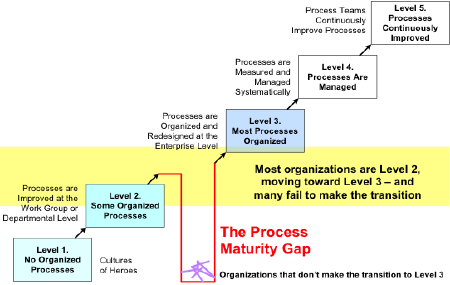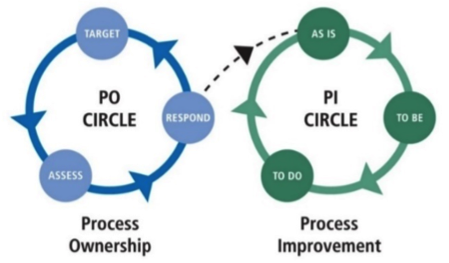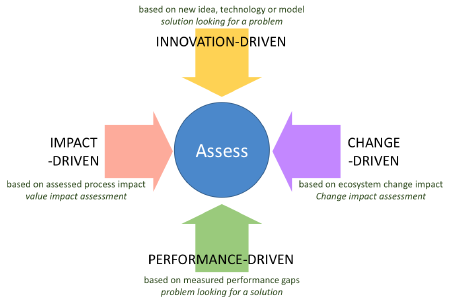Turning the Virtuous Circles
Without additional, conscious attention to cross-functional processes, nobody is accountable for the creation, accumulation, and delivery of value to an organization's customers and other stakeholders. The organization chart is silent on this issue. All organizations seek to deliver value, but without a relentless focus on processes, there is a critical gap between aspiration and reality.
Too often, process improvement initiatives are random acts of management with no systemic foundation. Organizations that continually improve and innovate the creation, accumulation, and delivery of customer value have process thinking embedded in culture and practice.
Business process management (BPM), more usefully called process-based management, is a management philosophy where the cross-functional processes that create, accumulate, and deliver value are central to strategic, operational, and tactical management. Processes are identified, performance targets are set, governance mechanisms are created, and performance is improved in a process-aware culture where everyone contributes and appropriate support is provided.
The required components are easily identified, and it's not hard to imagine them all working harmoniously together in some future state. What is not so easy to see is how to reach this nirvana.
What is the trajectory from the pristine theory of total process-centricity, to the gritty reality of a real organization with all of its complexities, latencies, impossible demands, and human frailties? How can process-based management be achieved in a practical and sustainable way?
An elegant solution is found in two virtuous circles, the Tregear Circles, that facilitate and deliver process-based management.
The chasm
Drawing on the lifecycle-chasm concept, first made popular by Geoffrey Moore, Paul Harmon has spoken of a BPM maturity development chasm, as shown in Figure 1. Surveys of BPM maturity show that most organizations attempting process improvement and management are between levels 2 and 3, with many never crossing the chasm to level 3. This is a problem because the significant, whole-of-organization benefits are realized at level 3 and above.

Figure 1. The Harmon BPM maturity chasm.
Most illustrations of the five-step maturity model imply a linear, even progression from level to level. This is misleading. The biggest step-change is from level 2 to 3. As Paul Harmon suggests, many don't make it across the chasm and face a difficult, perhaps impossible, climb to recover.
We might say that the level 2 team gets up a lot of momentum, and then runs and jumps … but it's in the nature of things that they can never jump completely across the gap, and they hit the wall and slide into the gap — and then crawl out on the level 2 side. There needs to be a senior executive on the level 3 side of the gap to reach out and give them a hand and pull them up.
For most organizations, a significant gap exists between aspirations for higher levels of BPM maturity and the lived reality. This is not to say that crossing the chasm is too hard or too dangerous to be attempted; the lesson is that, to succeed, organizations need to understand what is involved and properly prepare for the crossing.
Reaching nirvana
To their significant benefit, an increasing number of organizations successfully cross the chasm.
In the latest published data from the BPTrends State of BPM Survey, about 38% of respondents are at levels 3, 4, or 5, with approximately sixty per cent of those at level 3. They make it to a point where process-based management is becoming the instinctive approach, and process thinking is being embedded in the organization's culture and practice.
This is not to say that they have reached enlightened perfection, a process nirvana. However, they have created, and increasingly entrenched, a systemic response to performance problems, innovative ideas, and operational and strategic changes that drives continuous improvement in the creation, accumulation, and delivery of value to customers and other stakeholders.
How do they do that?
Two virtuous circles deliver process-based management at high levels of BPM maturity. Operating details vary, but the basic structures are present in successful process-based management environments. The two virtuous Tregear Circles are the PO circle (process ownership) and the PI circle (process improvement), as in Figure 2. Key activities in the PO circle are target—assess—respond. In the PI circle, the key elements are as is—to be—to do.

Figure 2. Tregear Circles.
The Tregear Circles are more than an interesting diagram. They describe a meta-model for practical process-based management, one from which benefits can accrue quickly. Details appear later but, first, an overview of each circle showing its general context and content.
The PO circle is continually testing the performance of all processes to uncover actual or emergent performance gaps driven by measurement, and innovation opportunities driven by ideas. A process performance target is set, then reality is assessed, and intervention is initiated if the results are not what they should be or could be, or if the target should be adjusted.
This continual sequence of target—assess—respond is the core of the process owner's role ensuring an unrelenting focus on the management of process, and therefore organizational, performance. It centers attention on the identification and management of process-performance gaps. The repeating cycle of target—assess—respond is the drumbeat of process ownership.
The PI circle identifies the current state, defines the future state, and then makes evidence-based changes to close prioritized performance gaps. Where actual or emergent process performance requires intervention, either because of deteriorating performance or an opportunity to innovate process execution, it is the PI circle that delivers process change.
The PO circle determines whether process adjustment is required in response to a current or emergent performance anomaly or a development opportunity; the PI circle discovers, details, and delivers the business-process change.
Conscious process-management uses the PO circle to maintain awareness of performance gaps and opportunities to challenge the status quo, and make evidence-based decisions about which gaps need to be partially or completely closed and in what order. Processes are selected for PI-circle treatment based on PO-circle analysis. Pervasive process improvement should be a systemic management act based on a constant search for processes that can be improved.
The PO circle turns with a cadence appropriate to the frequency of the particular process execution. The PI circle turns with a speed appropriate to the type of process intervention underway. While the PO circle triggers the PI circle, they act asynchronously.
The real benefit of continuous improvement comes after the easy changes have been made — and this demands not just the PI circle to deliver changes but also the PO circle to continue to uncover the opportunities.
Having the PO circle turning provides a continuous and integrated mechanism to test what benefits have been realized via process improvement, that is, by having the PI circle turning.
With these two virtuous circles consistently working well in a controlled way across the process architecture, an organization is working at high levels of process-management maturity. Achieving this state is not a trivial exercise — but once achieved, there is a mental and physical fly-wheel effect that is continually boosting process performance.
The circles also shape the roles involved in process-based management. Process owner accountabilities are defined by the PO circle. Too many organizations seem to define process owner success as having achieved perfection: 'We have no problems to fix, no opportunities to fulfill' — whereas successful application of the PO circle means the process owner continually finds problems to fix and opportunities to realize.
Target—assess—respond
Target—assess—respond is the essential cycle of process-based management. Identify a process and set a performance target, assess actual performance, and respond to the results if intervention is warranted, either to improve performance or change the target. This is the main game; all process management and process improvement comes down to this. If processes are not being improved, sometimes with radical effect, then all of this activity is wasted. Process-based management is both as simple and as complicated as the target—assess—respond circle.
For many organizations and their people, this is a new way of thinking and working. The difference is not only in the idea of assessing and reporting but also in assessing and reporting business-process performance, rather than the performance of organizational units alone; that is, focusing on value-creation chains from the process architecture, not just resource-management objects from the organization chart.
Target
Which critical few measures will indicate that the process is working well enough for a consensus of key stakeholders? An important parallel task is to ensure an effective and sustainable measurement method, that is, a practical way of gathering the performance data.
Discovery of the best measures and setting targets are facilitated by the process owner, supported by the office of BPM, in conjunction with others involved in process execution. Beyond the initial definition round for a particular process, formal reviews might be held:
- on a regular schedule, for example, every 12 months,
- in response to some change in the ecosystem in which the process operates,
- because it is clear from the performance data that the target is no longer appropriate.
Targets will change over time. When a new process settles into operation or as a particular performance concern comes under control, so the process changes in ways that require additional or different measures. Over time, measured data may come to show little or no variation, and since there is no need to measure a constant, the once-useful measure may now be a waste of effort.
The most important matter in this setting of process performance targets is to make sure that what is being measured is a good indicator of process performance. These targets will be relied on, and so they must be real. Elsewhere in the circle, the process owner will focus only on deviations from the targets, and this can only work if the correct measures and targets have been determined.
Assess
The assessment node of the PO circle is quite deliberately called Assess because more is involved than just the measurement of performance data. Measured performance data will be important of course, but there are three additional aspects to assess, as shown in Figure 3. The assessment has four possible triggers: performance anomalies, ideas for innovation, impacts of external change, internal plans for change.

Figure 3. Drivers of change.
Performance-driven assessment will look at the measured outcomes and assess whether the process is working within agreed limits. It will also test for trends that cause performance anomalies to develop. This is the classic mode of performance assessment based on the discovery of problems that need correction. However, there are other important ways to think about process assessment.
Just because a process is apparently working well doesn't mean it couldn't be improved. This gives rise to innovation-driven assessment as shown in Figure 3. Classic innovation-driven cases are the possible use of new technology, or use of a different business-operating model, or a different way to interact with customers.
This idea-driven mode of assessment integrates innovation lifecycles into the assessment of process-change options, removing artificial barriers between process improvement and innovation. Improvement and innovation are both about changing processes, and they must be part of the same management framework.
An assessment might also be made based on a desired business aim, for example, to increase market share in a particular area; the questions would then be about how processes could be changed to make that happen. Impact-driven assessment asks: If a given particular change is required, how does the process need to change?
The final mode, change-driven assessment, deals with changes in the context in which the process operates. If the process ecosystem has changed, what has to change about the process to maintain acceptable performance?
The PO circle assesses not just performance but also context, outcomes, and regeneration.
Respond
Without an appropriate response, assessment is waste. The purpose of assessment and measurement is to correct problems and, importantly, to find ways to avoid their reoccurrence.
In an environment where the management effort is concerned with overseeing individual functional areas, who will respond to cross-functional performance opportunities and concerns?
The process owner's role is to be constantly aware of performance gaps and to make informed decisions about the extent to which gaps should be closed and the appropriate timeframe for doing so. This response to actual or emergent process-performance anomalies, or to opportunities to raise the bar for process performance, is crucial for successful process-based management.
Generally, there are three types of response a process owner can make.
One, it might be that the process is performing within the target range and there are no changes to consider, so there is nothing to be done and no response is required.
Two, it might be that there is a need to change the measures or targets because there is a business case to either measure something new or set a different performance standard.
Three, it might also be that an intervention is required because there is something about the process performance that requires deeper analysis and consequent change. That will depend on the circumstances, but the options for an intervention might include one or more of these:
- commissioning a process improvement project (PIP),
- requesting more analysis of the underlying data,
- collecting more, or different, data to give deeper insights,
- discussing the problems with those involved in execution,
- discussing the problems with those receiving process outputs,
- considering the results of changing the performance target,
- watching the process being executed.
As is—to be—to do
As is—to be—to do is the classic process-improvement cycle — understand the current situation, define the target, and design the activities to achieve the change.
An important aspect, illustrated by the circle, is that the start and end must be with the 'as is'. The objective is not to design the 'to be', nor is it enough to create the plans for change ('to do'). What is required is not just a 'to be' or a 'to do', but a new 'as is'. The reality is that too many process-improvement projects make more recommendations than changes.
Successful changes are made here in the PI circle. The results of those changes are assessed in the always-turning PO circle.
Whether Lean, Six Sigma, BPTrends Redesign, or another process analysis and improvement approach is used, the PI circle objective is to give effect to the response wanted by the PO circle. In the context of the Tregear Circles, the PI circle is methodology-agnostic.
There are many ways to manage the PI circle. Some comments about key issues and common failure modes appear below.
As is
If the temptation is to think that what a process does is uniquely new, check carefully whether that is the case for everyone — perhaps it's new for just this organization and not for customers and other stakeholders.
Is it clear why the process is in its current form? Processes often change for good reason. Life can be a little complex, and users modify processes over time to account for the real world. Things identified as anomalies in a current process might be what make it work. Or they might also be just plain silly with no redeeming features. Clearly, it's important to know the difference.
Analyzing the 'as is' can be safe and comfortable. Don't get stuck there, though. Understand the problems, their causes, opportunities, and constraints — and then move on to remove the causes and neutralize the constraints; that is, to create a new 'as is'.
To be
This is where process analysts, and the business people with whom they work, really make a difference. Finding the best ways to deal with problems and opportunities is what it's all about.
To be credible, process improvement via any methodology must produce results that are qualitatively and quantitatively different to the much more generic (and common) approach of 'making things work better'. This needs to also happen with big changes, not just with small ones.
You will seldom be asked to make minor changes to inconsequential processes, but more often asked to deliver radical improvement to large, mission-critical processes.
The key to getting the best process improvement is to uncover all the problems and their causes, and all the opportunities and their constraints — and then to flush out all the possible change ideas. Culling should be done from a long list of possible changes to avoid the risk of using a short list that fails to identify the best options.
Process improvement is not about making lists of the obvious. It's about knowing what problems need to be solved, which opportunities might be realized, pushing the envelope to find all the possible change ideas, and then choosing the best. This should be a conscious, creative, deliberate, and repeatable process.
To do
Process change is the overall objective of process-based management. Recommendations for change need to be carried out as projects where real change is made.
At this point, many new people are likely to become drawn in without the benefit of deep involvement in the previous process-analysis activities. In the handover to change project execution, it is vital that the urgency and purpose of the change(s) are maintained to achieve the proposed process-performance benefits. Many a process transformation project fails at this hurdle.
Another disappointing development at this time is to put aside the process analysis work completed in the previous phase and start a completely new analysis pathway. This not only loses the process view but also asks stakeholders to repeat their involvement.
The appointment of a process owner before the projects start will go a long way toward avoiding these problems. If the PO circle is in operation, then carrying out the process changes in the PI circle will be closely monitored in the normal course of process governance.
Two circles — one objective
The Tregear Circles show the simplicity and complexity of process-based management. Turning together, they achieve what organizations struggle to achieve when focusing on just one alone.
Reflecting the execution of an organization's strategy, the PO circle defines the essential role of management: to continually uncover and resolve current and emergent performance concerns, and to capitalize on opportunities. Responding to these outcomes, the PI circle seeks, finds, and makes the changes required to close the performance gaps and realize the benefits. Once established, the circular momentum aids continuous improvement and offers resistance to any other influences that might act to slow it down.
With the Tregear Circles turning, strategy is executed through continually-improved and actively-managed business processes.
Frequently asked questions
PO or PI first?
Does the PO circle always come first? If an organization isn't ready for full-on process-based management and just wants to improve a process, all that is needed is the PI circle.
The real question is how to make the business case for process-based management — that is, to make the case for getting both circles turning.
There are two perspectives. With C-level support for the idea of process-based management, the business case reflects the compelling idea that processes deliver value and, therefore, must be managed. Without C-level support, the hook needs to be more short-term and practical (cost savings, shorter cycle times, quality improvements).
If the idea of process-based management strikes a chord with decision-makers, they will see the value of the PO circle. If the focus is on quantitative improvements to particular processes, then starting with the PI circle will make more sense.
Having been around the PI circle a few times, the value of the PO circle will become apparent — indeed, it should be seen as mandatory. Eventually, everyone needs to see many processes improved; it's a question of where you start.
Isn't the PO circle about process management (PM)?
It is often suggested that the PO circle is about process management and should therefore be the 'PM circle', not the PO circle.
While this can be argued, the PO terminology is deliberately used to emphasize the critical role of the process owner, a role often poorly defined and, hence, poorly executed. Using the circles, process owners know what they need to do and how to do it (and yes, they are doing process management).
Don't we need an arrow from PI to PO in the diagram?
Another common suggestion is to add an arrow going back from the PI circle to the PO circle to indicate feedback.
This is neither needed nor methodologically correct. The PO circle is turning continually and, from time to time, it triggers the PI circle. While the PI circle is turning, the PO circle continues to turn — that is, it continues to assess performance against agreed targets. The feedback is built in, and the PO circle continually uses performance data, ideas, required effect, and change demands to assess process performance.
How fast should the circles turn?
The circles don't need to spin, but they do need to turn.
How fast the PO circle turns will depend on the process — it could be in real time, or perhaps quarterly; it depends on the cycle time of the process. Circle speed may also change over time or on a seasonal basis.
The PI circle will also turn at different speeds, largely unrelated to the PO circle speed, depending on the nature and complexity of the process-improvement activity and the analysis methodology used. A common failing for process-improvement projects is that they take too long to deliver benefits, that is, the PI circle turns too slowly.
The important thing about circle speed and putting process-based management into operation is to get the circles turning.
~ This column is an edited extract from the book, Reimagining Management, to be published in December 2016.
# # #
About our Contributor:
Online Interactive Training Series
In response to a great many requests, Business Rule Solutions now offers at-a-distance learning options. No travel, no backlogs, no hassles. Same great instructors, but with schedules, content and pricing designed to meet the special needs of busy professionals.











How to Define Business Terms in Plain English: A Primer
How to Use DecisionSpeak™ and Question Charts (Q-Charts™)
Decision Tables - A Primer: How to Use TableSpeak™
Tabulation of Lists in RuleSpeak®: A Primer - Using "The Following" Clause
Business Agility Manifesto
Business Rules Manifesto
Business Motivation Model
Decision Vocabulary
[Download]
[Download]
Semantics of Business Vocabulary and Business Rules